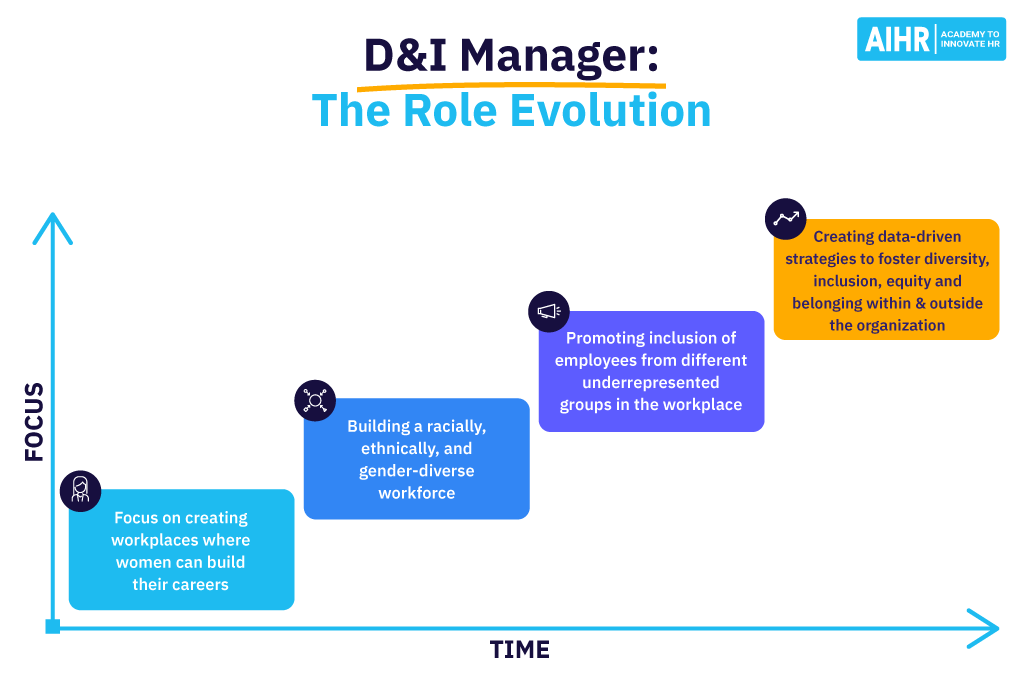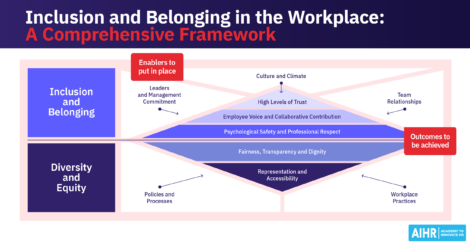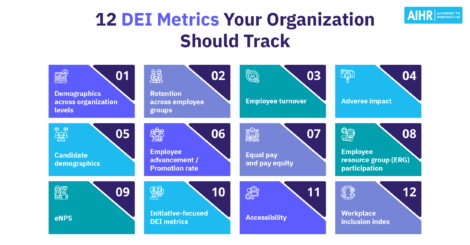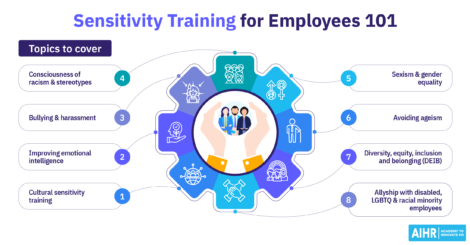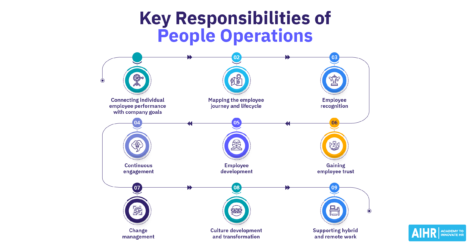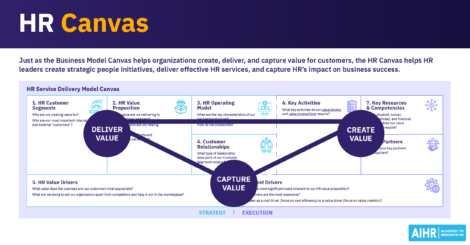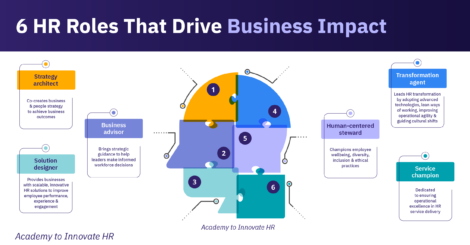33 Interview Questions for Diversity and Inclusion Managers
“When we listen and celebrate what is both common and different, we become a wiser, more inclusive, and better organization,” says seasoned people professional Pat Wadors. Diversity and Inclusion Managers play a key role in creating a work environment that truly values diversity.

Getting ready for an interview for a Diversity and Inclusion Manager role? A D&I Manager is a specialist senior role and, therefore, requires rigorous preparation with specific knowledge, competencies, and skills that you have to display in the interview. You can expect tough questions, especially about how you manage various challenging situations in the workplace.
In this article, we’ve listed the top interview questions for Diversity and Inclusion Managers and what to focus on when answering them. Let’s dive in!
Contents
Diversity and Inclusion Manager job description
Role-specific interview questions
Competency interview questions
Behavioral interview questions
Situational interview questions
Diversity and Inclusion Manager job description
A Diversity and Inclusion Manager is responsible for crafting, recognizing, and implementing a company’s Diversity, Inclusion, Equity, and Belonging (DEIB) efforts. This includes advising line managers on strategies and best practices, ensuring the organization follows appropriate legislation, and implementing DEIB practices across all HR processes.
Some of the key responsibilities of a Diversity and Inclusion Manager include:
- Fostering a diverse and welcoming workplace at all levels of the organization through the development of company-wide DEIB programs
- Constantly improving the company’s talent pipelines and recruitment practices to increase candidate diversity
- Utilizing data analytics to highlight the positive impact of DEIB programs on the executive team.
The skills needed for the job are:
- DEIB management: This involves designing and implementing programs that promote DEIB in the workplace, which are central to creating an inclusive workplace culture.
- HR advisory: Providing expert guidance ensures that recruitment, promotions, and employee relations are handled through an inclusive lens, reducing bias and fostering equity.
- HR strategy formulation: Developing HR strategies that incorporate DEIB principles ensures that diversity initiatives are aligned with the company’s broader objectives, fostering long-term inclusion throughout the organization.
- Networking: Building relationships with internal stakeholders and external partners is crucial for expanding the reach of DEIB initiatives and creating a supportive, collaborative environment.
- Change management: Managing organizational change is essential to successfully implement DEIB initiatives, as it helps overcome resistance and ensures smooth transitions toward a more inclusive workplace.
We’ve compiled a list of 33 interview questions for Diversity and Inclusion Managers, together with some ideas for formulating your answers. Potential interview questions are limitless, and businesses use many different types as their standard. However, getting familiar with sample questions will help you prepare for an interview for your next role and ultimately ace it.
For this article, we’ve focused on the four categories of role-specific, behavioral, competency, and situational D&I Manager interview questions. Here we go!
Role-specific interview questions
Role-specific questions allow you to showcase that you understand what needs to be done as a Diversity & Inclusion Manager. It gives you the opportunity to show you have read through the job description, done prior research on the organization’s structure and D&I strategy, and explain how you can contribute to it.
1. “Why are you interested in diversity and inclusion?”
In your answer, share a personal or professional experience that sparked your interest in DEIB, and discuss how it aligns with your values or career goals. Mention how your passion for fostering an inclusive workplace drives you to make a measurable impact in organizations.
2. “How do you keep up to date with the latest news and practices in D&I? What resources do you use?”
You should be able to demonstrate that you know what’s top of mind and newsworthy in D&I. It is a constantly evolving field, and with some noteworthy and seminal moments, it is important to show that you’re knowledgeable about what’s happening and what’s coming.
You should mention a few resources (books, websites, journals) that you follow. Mention the trends you have noticed, as well as any specific changes. It might be new legislation related to D&I, for example.
It’s a good idea to subscribe to Google Alerts to receive the latest D&I news, listen to podcasts, subscribe to relevant social media groups, and join one or two useful newsletters.
3. “What are the biggest challenges D&I professionals are currently facing?”
This is an opportunity to showcase your experience and knowledge in the D&I field. The challenges and maturity in D&I are not the same as 20 or even five years ago. To answer this question, present challenges that D&I professionals have faced in the past. Then, explain how they have changed over time to the current day.
Feel free to use an anecdote where you can demonstrate current challenges – and also how you worked to overcome them. Ensure your answer is aligned with the job description and industry. For instance, if your D&I role is in the entertainment industry, make it specific to that. To recap, don’t just state the challenges but also discuss how to overcome them.
4. “What DEIB training have you received?”
Start with your most recent D&I training and work backward. For example, mention your Diversity, Equity, Inclusion, and Belonging certification. Be specific about your educational background – so if you have a Human Resources or Organizational Psychology degree, expand on the specific diversity and inclusion modules you completed.
Also, it showcases an element of continuous learning. This might be recent conferences or workshops you attended or a webinar series you’re subscribed to. Highlight a few key pieces of training that are a must-have (unconscious bias and implicit training, cultural awareness, stereotyping, anti-harassment, legal training, etc.).
5. “Who forms part of your DEIB team? How do you ensure everyone knows their responsibilities?”
This interview question is an opportunity to showcase your strategic thinking. Study the structure of the organization you’re applying to know how to prepare your answer. Your diversity team should go beyond just the D&I and HR employees. It should include the leadership team and other functional members such as IT, finance, marketing, and legal / compliance.
Explain how you would bring all of the different members to work towards a shared vision and set objectives with KPIs. Explain the different responsibilities of each member and the reason behind them.
6. “How do you stay informed about the latest updates to D&I labor law matters?”
Be sure to quote the specific website or gazette you use to stay up to date with D&I labor law matters. For example, if you’re based in the US, you might note that you keep an eye on the US Department of Labor website to stay informed.
And on a global level, you can stay up to date with what’s happening in the International Labour Organization related to D&I. For bonus points, mention a recent change in labor law in your country/state. That will show that you are all caught up with what’s happening.
7. “What do you see as a major event, trend, or change that will change diversity and inclusion in the next five years?”
This is different from explaining what the current trends are – it’s an opportunity to show that the organization should invest in you. Look at trending topics, such as remote work or artificial intelligence (e.g., bias and AI), and discuss its future impact on DEIB. Mention a few studies or industry research that backs up your claims.
Also, discuss the skills and competencies needed for D&I professionals to deal with this and what you’re doing to stay sharp.
8. “How would you describe the way you think about diversity and inclusion now? How has it changed over time?”
This question allows you to demonstrate your knowledge and maturity over time. Showcase how movements like #MeToo or Black Lives Matter have risen, and how the new traditions of the annual diversity reports have come about.
Discuss how organizations have shifted from D&I as just a tick-box exercise to evolving as a business imperative and strategic advantage. Explain how the understanding is changing from diversity to inclusion to include other dimensions – equity and belonging.
9. “How would you describe the typical day of a Diversity and Inclusion Manager?”
This is to measure if you know and understand the responsibilities of a D&I Manager. Explain how you can lead teams, build relationships, and research and implement strategic initiatives. Describe how you would track metrics and create a DEI dashboard for the organization to be able to make data-driven decisions.
10. “How would you align our organization’s diversity and inclusion initiatives with our overall business strategy?”
Show your understanding of how DEIB efforts can support broader organizational goals, such as employee engagement, innovation, or customer satisfaction. Discuss how you’d integrate DEIB into various business functions like recruitment, product development, and leadership.
11. “What long-term changes would you like to see in the field of diversity and inclusion over the next decade?”
Reflect on trends like increased remote work, AI, or global cultural shifts, and how they might shape DEIB efforts. Discuss your vision for more inclusive workplaces and how organizations can proactively address future challenges.
Competency interview questions
A major reason to hire a Diversity & Inclusion Manager is that it is a specialist role. It’s not just an HRBP with a D&I focus, but a specific individual to look at D&I issues in the workplace. Competency-based interview questions explore your understanding, knowledge, and skills in the field of D&I. To prepare, you should refresh everything there is to know about D&I.
12. “What is your understanding of diversity and inclusion?”
Don’t provide a textbook definition of D&I – but rather what you understand it to be in the context of society and the workplace. Provide an anecdote of what it means to you. Again, remember to explain that D&I goes beyond the numbers and has expanded to include equity and belonging (DEIB). To conclude, describe an ideal workplace and what it looks like when they prioritize DEIB.
13. “What is your approach to understanding the perspectives of colleagues from different backgrounds?”
Explain how you would go about understanding different perspectives, such as active listening, empathy, and seeking out feedback, to ensure you genuinely appreciate diverse viewpoints. On a broader organizational level, you can mention strategies like hosting focus groups, one-on-one meetings, or anonymous surveys to gather a wide range of perspectives for better decision-making.
14. “What role do you believe employee resource groups (ERGs) play in D&I?”
Explore the concept of ERGs and what makes them effective or not. Provide tangible examples of how you have supported the growth of an ERG and how you measure success.
An ERG is an employee-led diversity and inclusion initiative – so explain how you, as a D&I Manager, would encourage support and get employees excited about them.
15. “What practices would you implement to ensure we don’t recruit with bias?”
Give three or four real inclusive hiring initiatives aiming to reduce bias in the recruitment process. You could mention the following:
- Increasing the use of data in decision-making
- Structuring the interview process
- Removing gendered wording from job descriptions
- Training your hiring team on unconscious bias and
- Thoroughly analyzing each step in the recruitment process for adverse impact.
16. “What is the biggest mistake organizations make regarding diversity and inclusion?”
This is a great way to demonstrate how you would be a leader in the organization by giving a succinct description of where organizations go wrong with D&I. Some of the most common mistakes include creating D&I policies but not implementing or putting them into action. As you’re being hired as the D&I Manager, you should also emphasize this would be your key priority should you be hired.
Another big mistake often made is that organizations don’t respond publicly or internally to a social situation.
17. “How much do you consider HR metrics when deciding on your diversity & inclusion strategy?”
Emphasize how you incorporate HR metrics like hiring rates, promotions, and representation into the planning phase of your DEIB strategy. Mention how you analyze data to identify gaps and set measurable goals. Some examples could include tracking diversity in talent pipelines, measuring the retention rate of underrepresented groups, or evaluating pay equity as part of shaping your strategy.
18. “How do you evaluate the effectiveness of diversity and inclusion programs?”
As we’ve established above, data is essential when it comes to diversity & inclusion – and you should emphasize this. It’s not enough to just feel good about D&I; but there should be tangible changes in representation. This can be tracked through D&I metrics (e.g., representation of various diversity groups at senior levels or eNPS for underrepresented groups). Discuss specific tools or methods you use to gather insights and make adjustments as needed.
19. “How versatile are you working with software systems in DI&?”
Firstly, demonstrate your willingness to make technology a key strategic tool for your D&I strategy. Then demonstrate your awareness of the considerations when using technology.
The benefits include automating parts of many workplace processes (recruitment, video-based interviews, learning and development, analytics) to enable your D&I strategy. It can also have many shortfalls, such as bias in technology systems, interpreting analytics without context, etc.)
20. “What are your biggest strengths as a Diversity and Inclusion Manager?”
Highlight specific technical skills to being an excellent D&I Manager (DEIB management, HR strategy formulation, change management). Demonstrate you have strengths in soft skills (such as active listening, conflict resolution, networking, etc.).
Develop your skills in DEIB
Landing a Diversity and Inclusion role requires more than passion—it takes proven skills and a deep understanding of DEIB practices. By mastering these areas, you’ll be able to demonstrate your ability to create impactful D&I initiatives and contribute meaningfully to a company’s culture.
In AIHR’s Diversity, Equity, Inclusion & Belonging Certificate Program, you’ll gain the knowledge and expertise needed to confidently showcase your ability to lead DEIB efforts, design inclusive strategies, and address complex challenges in any organization.
This self-paced program will prepare you to excel in your D&I interview and make a strong case for your role as a DEIB leader.
Behavioral interview questions
Being able to handle challenging situations as a D&I Manager is crucial, as you will often be called in to deal with a sexual harassment case or an incident of racism, for example. Therefore, you need to describe prior situations you found yourself in and how you reacted.
21. “What initiatives or steps have you taken to champion diversity & inclusion in the workplace?”
Use the STAR (Situation, Task Action, Result) interview method when you’re answering this question. Refer to a specific situation where you recognized D&I needed to be championed and the steps you took to improve it. Highlight where you were specifically involved, and then explain the outcome.
For example, explain how an employee net promoter score was low for a particular diversity group and what steps you took to improve it, or how you challenged representation in senior leadership levels.
22. “What steps have you taken to get the leadership team to champion D&I initiatives?”
Diversity and inclusion initiatives are only successful if supported by the leadership team in the organization. Choose a specific example where you influenced and persuaded leaders to make the right decisions regarding D&I.
Explain how you convinced the leadership team (through data, listening skills, negotiating, compromising, etc.). If possible, showcase how you secured a budget for D&I initiatives.
23. “What opportunities have you had working and collaborating with diverse and inclusive populations?”
Provide specific examples where you collaborated with individuals from diverse backgrounds, detailing the challenges and successes of those experiences. Use the STAR method to describe your role, the steps you took, and the outcomes that demonstrated positive impacts on inclusion.
24. “Can you give us an example where you created a sense of belonging for employees from diverse communities in the workplace?”
Be specific in your example – mention that exact group and what the challenge was. Explain what you did to understand the issue (what caused a feeling of lack of belonging) and what you did to overcome it.
Demonstrate that you have spoken to employees and not just decided based on what you think. Explain how you celebrate differences, use employee resource groups, and use data to measure results.
25. “How did you handle a situation where an employee acted in a sexist, racist, or culturally insensitive manner?”
Demonstrate your understanding of HR investigation procedure (from a legislative perspective) and dealing with emotions (of both the employee who was accused and the victim). Explain what happened, the outcome, and how you communicated this to those involved and the broader company.
26. “Describe the most challenging diversity & inclusion situation you faced. How did you handle it? What was the outcome? What could you have done better?”
This is your chance to demonstrate one example which showcases your knowledge, competencies, and emotional intelligence. By using the STAR method, explain the knowledge (theory, laws, case studies) you used to approach the situation, how you dealt with it (competencies – change management, active listening, persuasion), and what the follow-up was.
Focus on the employee and how you made them feel throughout the process.
27. “Can you share an example of how you handled resistance to a DEIB initiative?”
Apply the STAR method to describe a situation where you encountered pushback, explaining how you addressed concerns and found common ground. Highlight your communication skills and strategies for overcoming resistance to foster buy-in.
Situational interview questions
Diversity & Inclusion Managers consistently deal with tough situations around religion, sexual orientation, race, gender, culture, etc. Situational interview questions gauge hows you handle these scenarios – particularly as the subject matter expert and consultant on D&I.
28. “Explain how you would approach a situation where you’d have to discuss a difficult topic, such as religion, sexual orientation, or race in the workplace.”
Demonstrate how you set objectives and planned for every scenario. Showcase your facilitation skills, get everyone involved in the situation, and create psychological safety. Explain the follow-up steps. Use the BRAVE framework suggested by MIT Sloan.
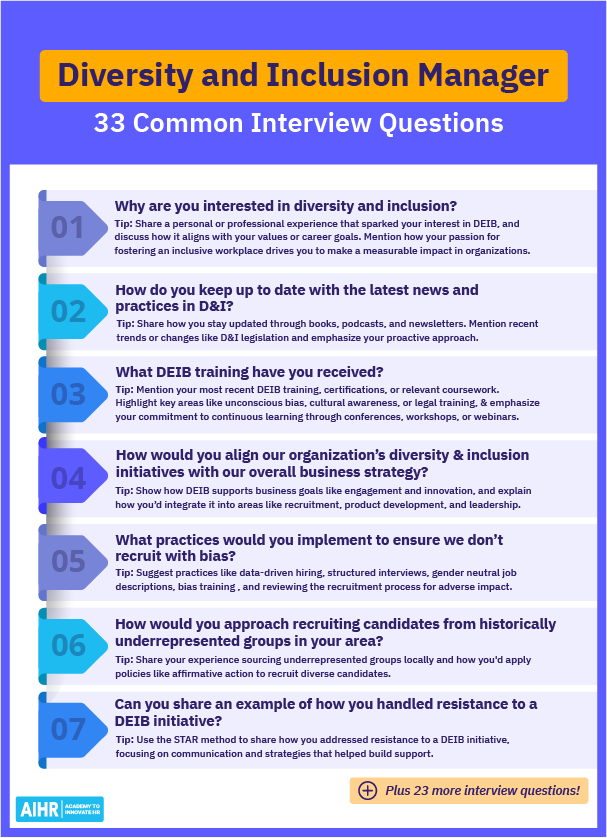
29. “How would you approach recruiting candidates from historically underrepresented groups in your area?”
Depending on your location, you should know which groups have been historically underrepresented. Discuss your experience with sourcing and recruiting candidates from underrepresented groups and showcase your understanding of specific policies and practices, such as affirmative action, and how you would apply them.
30. “What are a few methods you would use to educate employees on diversity and inclusion in the workplace?”
This question is an opportunity for you to show that you’re well-versed in different learning and training methods and how to apply them. For example, you can mention a company-wide meeting you conducted or a webinar. You can also discuss a variety of D&I training formats you implemented in the past, such as a video or email series.
Lean on your past experience in the education you provided and its outcome (note any improvement, completion rates, employee feedback, etc.)
31. “If you discovered a member of leadership was guilty of misconduct regarding a D&I situation, what would you do?”
If you don’t have an example to quote, explain what you would do in this scenario. Make sure to highlight how you would hold leadership “accountable” for the actions – and treat them with the same procedure as any employee in the same situation.
32. “How would you handle a situation where a team is struggling with unconscious bias in decision-making?”
Describe how you would assess the situation, provide training, and implement long-term strategies to reduce bias, such as structured interviews, interview evaluations forms, or bias-awareness workshops. Emphasize the importance of ongoing education and accountability in managing bias. For example, this could include establishing a review system where managers’ interview evaluations are audited for consistency across different demographic groups.
33. “It’s your first day on the job here. What is the first task you will tackle?”
There’s no real answer for this – but rather an opportunity to showcase your personality and priorities. Mention that you would set up meetings with key stakeholders, not only senior members. Also, meet with employees experiencing D&I issues on the ground. Talk about the research and data you would like to get a hold of and how you would introduce your approach to your team and the company.
How to talk about diversity in an interview
Here are five tips for talking about diversity in a job interview, specifically for a Diversity and Inclusion role like a D&I Manager or D&I Director:
- Be authentic and personal: Share personal experiences that demonstrate your genuine commitment to diversity and inclusion. Explain why D&I matters to you personally and professionally, connecting it to your values or past roles.
- Example: Discuss how a specific interaction with a colleague from a different background shaped your understanding of the importance of inclusion.
- Show you understand the big picture: Talk about diversity beyond just numbers; focus on inclusion, equity, and belonging. Discuss how diversity initiatives can benefit the entire organization, improving innovation, employee engagement, and overall success.
- Example: “I see diversity as a competitive advantage, helping to foster creativity and innovation by bringing together different perspectives.”
- Demonstrate a strategic mindset: Position yourself as someone who can align D&I with business goals. Explain how you would use data, KPIs, and collaboration with other departments (HR, leadership, etc.) to implement and track successful diversity strategies.
- Example: “I use metrics like employee engagement and retention among diverse groups to measure the effectiveness of D&I initiatives and make data-driven adjustments.”
- Highlight specific achievements: Provide concrete examples of how you’ve implemented successful D&I initiatives or programs. Use measurable outcomes, such as increased representation, improved employee satisfaction, or reduced bias in hiring processes.
- Example: “In my last role, I helped increase the representation of women in leadership by 20% over two years through targeted recruitment strategies.”
- Be ready to discuss challenges: Acknowledge the complexities and challenges of implementing D&I programs, such as resistance, unconscious bias, and legal changes. Share examples of how you’ve navigated these challenges, emphasizing your problem-solving skills and resilience.
- Example: “When we faced resistance to implementing diverse interview panels due to time concerns, I used data to show how it improves hiring outcomes and reduces new hire turnover. I streamlined the process, provided training, and over time, we saw a 15% increase in diversity among new hires.”
Over to you
You will never know the exact questions you will be asked at your next interview. However, reviewing these interview questions for Diversity and Inclusion Managers will help you reflect on your past experience, remember different situations that you had to handle, and formulate what you want to communicate in the interview.
Of course, don’t forget to prepare a couple of questions yourself to understand the role and the organization better. Good luck with interviewing!
Learn more
Related articles
Are you ready for the future of HR?
Learn modern and relevant HR skills, online






